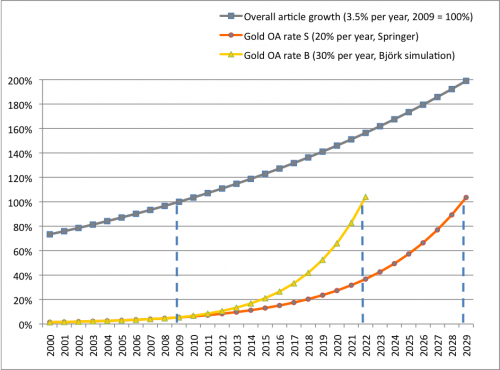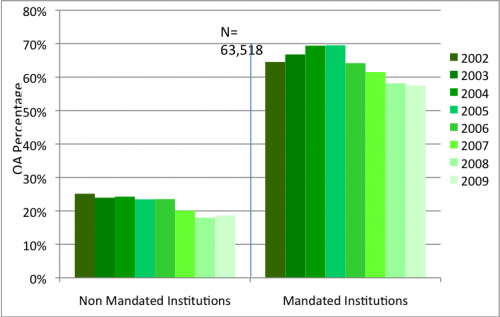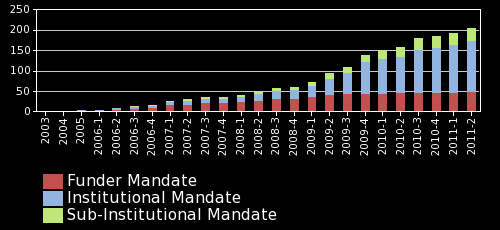Wednesday, June 29. 2011
Megajournals, Quality Standards and Selectivity: Gaussian Facts of Life
SUMMARY: It is obvious that broad-spectrum, low-selectivity, pay-to-publish mega-journals -- whether Open Access or not Open Access -- can help meet many researchers' need to publish today, but it is certainly not true that that's the only way, the best way, or the most economical way to provide Open Access to their articles.
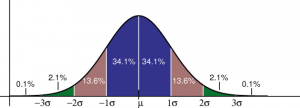 Like height, weight, and just about every other biological trait (including every field of human performance), scholarly/scientific quality is normally distributed (the "bell" curve), most of it around average, tapering toward the increasingly substandard in the lower tail of the bell curve and toward increasing excellence in the upper tail.
Like height, weight, and just about every other biological trait (including every field of human performance), scholarly/scientific quality is normally distributed (the "bell" curve), most of it around average, tapering toward the increasingly substandard in the lower tail of the bell curve and toward increasing excellence in the upper tail. For some forms of human performance -- e.g., driving or doctoring -- we are satisfied with a pass/fail license cut-off.
For others, such as sports or musical performance, we prefer finer-grained levels, with a hierarchy of increasingly exacting -- hence selective -- performance standards.
But, as a matter of necessity with a finite (though growing) population and a bell curve with tapered tails, the proportion (and hence the number) of candidates and works that can meet higher and higher performance standards gets smaller and smaller.
Not only can everyone and everything not be in the top 10% or the top 1% or the top 0.1%, but because the bell curve's tail is tapered (it is a bell, not a pyramid), the proportion that can meet higher and higher standards shrinks even faster than a straight line.
Scholars and scientists' purpose in publishing in peer-reviewed journals -- indeed, the purpose of the "publish-or-perish" principle itself -- had always been two-fold: (1) to disseminate findings to potential users (i.e., mostly other scholars and scientists) and (2) to meet and mark a hierarchy of quality levels with each individual journal's name and its track-record for the rigor of its peer review standards (so users at different levels can decide what to read and trust and so quality can be assessed and rewarded by employers and funders).
In principle (though not yet in practice), journals are no longer needed for the first of these purposes, only the second -- but for that, they need to continue to be selective, ensuring that the hierarchy of quality standards continues to be met and marked.
It is obvious that broad-spectrum, low-selectivity, pay-to-publish mega-journals -- whether OA or not OA -- can help meet many researchers' need to publish today, but it is certainly not true that that's the only way, the best way, or the most economical way to provide OA for their articles:
Harnad, S. (2010) No-Fault Peer Review Charges: The Price of Selectivity Need Not Be Access Denied or Delayed. D-Lib Magazine 16 (7/8).Peer review itself, however, will, like homeostasis, always "defend" a level, whether that level is methodological soundness alone, methodological soundness and originality, methodological soundness, originality and importance, or what have you. The more exacting the standard, the fewer the papers that will be able to meet it. Perhaps the most important function of peer review is not the "marking" of a paper's having met the standard, but helping the paper to reach the standard, through referee feedback, adjudicated by an editor, sometimes involving several rounds of revision and re-refereeing.
ABSTRACT: Plans by universities and research funders to pay the costs of Open Access Publishing ("Gold OA") are premature. Funds are short; 80% of journals (including virtually all the top journals) are still subscription-based, tying up the potential funds to pay for Gold OA; the asking price for Gold OA is still high; and there is concern that paying to publish may inflate acceptance rates and lower quality standards. What is needed now is for universities and funders to mandate OA self-archiving (of authors' final peer-reviewed drafts, immediately upon acceptance for publication) ("Green OA"). That will provide immediate OA; and if and when universal Green OA should go on to make subscriptions unsustainable (because users are satisfied with just the Green OA versions) that will in turn induce journals to cut costs (print edition, online edition, access-provision, archiving), downsize to just providing the service of peer review, and convert to the Gold OA cost-recovery model; meanwhile, the subscription cancellations will have released the funds to pay these residual service costs. The natural way to charge for the service of peer review then will be on a "no-fault basis," with the author's institution or funder paying for each round of refereeing, regardless of outcome (acceptance, revision/re-refereeing, or rejection). This will minimize cost while protecting against inflated acceptance rates and decline in quality standards.
Since peer review is an active, dynamical process of correction and improvement, it is not like the passive assignment of a letter grade to a finished work -- A, B, C, D. Rather, an author picks a journal that "defends" a target grade (A or B or C or D), submits the paper to that journal for refereeing, and then tries to improve the paper so as to meet the referees' recommendations (if any) by revising it.
There are, in other words, A, B, C and D journals, the A+ and A journals being the highest-standard and most selective ones, and hence the least numerous in terms of both titles and articles, for the Gaussian reasons described above.
A mega-journal, in contrast, is equivalent to one generic pass/fail grade (often in the hope that the "self-corrective" nature of science and scholarship will eventually take care of any further improvement and sorting that might be needed -- after publication, though "open peer review").
Maybe one day scholarly publication will move toward a model like that -- or maybe it won't (because users require more immediate quality markers, and/or because the post-publication marking is too uncertain and unreliable).
But what's needed today is open access to the peer-reviewed literature, published in A, B, C and D journals, such as it is, not to a pass/fail subset of it.
Hence pass/fail mega-journals are a potential supplement to the status quo, but not a substitute for it.
Stevan Harnad
EnablingOpenScholarship
Thursday, June 23. 2011
Elsevier & IOP Still Fully Green & Angelic: Just Ignore Incoherent Distinctions

A Green publisher is a publisher that endorses immediate self-archiving of their authors' accepted final drafts (but not necessarily the publisher's version of record) free for all on the web, immediately upon acceptance for publication.
That's all it takes for a publisher to be Green (and to be on the Side of the Angels).
In the new language that some Green publishers have jointly adopted for their copyright transfer agreements recently, some new conditions have been added, based on three distinctions. Not all Green publishers have added all three conditions (Elsevier, for example, has only added two of them, IOP all three), but it does not matter, because all three distinctions are incoherent: They have no legal, logical, technical nor practical substance whatsoever. The only thing that a sensible person can and should do with them is to ignore them completely.
Here they are. (The actual wording in the agreement will vary, but I am giving just the relevant gist.)
(1) You may self-archive your final draft on the web, immediately upon acceptance for publication, free for all -- but you may only do it on your personal institutional website, not in your institutional repository.This distinction is completely empty. Your institutional website and your institutional repository are just institutional disk sectors with different (arbitrary) names.
(2) You may self-archive your final draft on the web, immediately upon acceptance for publication, free for all -- but you may not do it where there is "systematic distribution."All websites are systematically harvested by google and other search engines, and that's how most users search and access them.
(I think what the drafters of this absurd condition may have had in mind is that you may not deposit your paper on a website that tries to systematically reconstruct the contents of the entire journal. They are perfectly right about that. But an institutional repository certainly does not do that; it simply displays its own authors' papers, which are an arbitrary fraction of any particular journal. If there is anyone that publishers can -- and should -- go after, it is 3rd party harvesters that reconstruct the contents of the entire journal.)
(3) You may self-archive your final draft on the web, immediately upon acceptance for publication, free for all -- but not if you are mandated to do it (i.e., you may if you may but you may not if you must).Authors are advised to advise their publishers, if ever asked, hand on heart, that everything they do, they do out of their own free will, and not out of coercion (and that includes the mandate to publish or perish).
If anyone is minded to spend any more time on this nonsense than the time it took to read this message, then they deserve everything that's coming (and not coming) to them.
Elsevier and IOP authors: Just keep self-archiving in your IRs, exactly as before, and ignore these three silly new clauses, secure in the knowledge that they contain nothing of substance.
Stevan Harnad
Enabling Open Scholarship
Sunday, June 19. 2011
Richard Poynder Interview: How Fast Is Open Access Growing?

Open Access by Numbers
Open and Shut, 19 June 2011
Figure 1. Springer Gold OA growth curve S (20% per year) and simulated Björk growth curve B (30% per year) (Laakso et al 2011) equated for year 2009. Note that the Björk curve would reach 100% Gold OA for all journals (ISI + non-ISI) in 2022, at a time when the Springer curve would not yet have reached 40% for ISI journals. Laakso et al's estimate of 30% Gold OA growth and Springer's estimate of 20% Gold OA growth can be reconciled if we note that the 30% rate was as of 2000, and has slowed to 20% as of 2005. More important, either way, the Björk curve would not reach 60% till 2019, and the Springer curve would not reach 60% till 2025, whereas the four mandated repositories had already reached 60% in 2004-2006, within two years of having adopted their mandates (Figure 2, below).
Figure 2. Percent green OA self-archiving averaged for the four institutions with the oldest self-archiving mandates, compared to the percentage for control articles from other institutions published in the same journals (for years 2002-2009, measured in 2011). Respective totals are derived from Thompson-Reuters-ISI index. Mandates triple the percent Green OA (Figure 3, below).
Figure 3. Yearly increase in the number of Green OA self-archiving mandates adopted by institutions and funders (data from ROARMAP).
Stevan Harnad
EnablingOpenScholarship
Wednesday, June 15. 2011
SPARC Europe's OA Suggestions to EC: Part Sense, Part Nonsense, Part Irrelevance
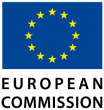
SPARC Europe's OA suggestions to the EC are part sense, part nonsense, part irrelevance:SUMMARY: Calling for Green Gratis OA Mandates makes sense. Calling for Libre OA, extra Gold OA funds, or double-standards for journal quality does not. Call for the reasonable. Grasp the reachable. And trust nature to take care of the rest.
Sense:
- Open Access means immediate access, without delaying mechanisms[assuming that what is meant here is to extend the EC Green OA self-archiving mandates]
- strive for the shortest embargo period possible
- help in increasing awareness among researchers
- Open Access via Institutional Repositories (green road) and Open Access via publishing (gold road) are complementary strategies
- extend the [EC] Open Access policies to all research areas
Nonsense:
- Open Access in Institutional Open Access Policies should refer to “Libre” Open Access: free to access and free to re-use[Libre OA asks for much more than Gratis OA (free online access) and we are nowhere near having Gratis OA yet. It is counter-productive to over-reach and ask for more when you don't even have the less. Mandating Green Gratis OA will eventually lead to Libre OA too, but demanding Libre OA now will lead nowhere for many more years to come.]
- communicate that the quality of Open Access peer-reviewed journals is equal to the quality of subscription peer-reviewed journals[Utter, utter nonsense, parroted year in and year out by an endless succession of well-meaning know-naughts: The quality of a peer-reviewed journal is what it is, regardless of its cost-recovery model. Is the EC supposed to give a-priori quality bonuses to journals, based on whether or not they happen to be OA, rather than letting them earn it, with their peer-review standards and quality track-records, like all other journals?]
- call for subscription-based publishers to allow authors and institutions to deposit metadata into Open Access repositories and to support Creative Commons licensing of these materials[Why call for this, since authors can already deposit their metadata? What publishers should be called upon to do is simply to endorse immediate Green OA self-archiving of the author's final draft, as over 60% of journals already do ("being on the side of the angels"]
Irrelevance:
- make funding available to cover the costs of Open Access publishing[Does the EC have spare funds for this? What is needed is OA, not more money to pay publishers. Institutional subscriptions are paying for publication already. What is needed is to mandate Green Gratis OA self-archiving. If and when funds are needed to pay for Gold OA publishing, they will come from the release of the institutional subscription funds through cancelation.]
- call for subscription-based publishers to start the transition of subscription journals towards Open Access["Calling on publishers to start the transition" will have no effect and is hence irrelevant. Mandating Green OA, in contrast, will generate OA, and then the publishers will start planning for a transition of their own accord as a natural matter of course if and when mandated Green OA begins causing cancelation pressure.]
- provide an infrastructure enabling publisher content to be harvested and deposited into institutional repositories[What is needed is not an infrastructure. What is needed is a mandate to deposit.]
Stevan Harnad
Enabling Open Scholarship
Friday, June 10. 2011
Aureatio Praecox: The Three Reasons Gold OA Is Premature
 Jan Szczepanski [JSZCZ] wrote in the American Scientist Open Access Forum:
Jan Szczepanski [JSZCZ] wrote in the American Scientist Open Access Forum:JSZCZ: After collecting free e-journals for more than ten years I'm amazed to read a phrase like this one produced by Steven Harnad.All OA content -- whether green or gold -- is welcome, valuable and important. That is not the issue. The issue is how to increase OA content.SH: "But gold OA is still premature (whether for journals or books)."I have concentraded on journals in humanities and social sciences and have more than 12.000 for the moment.
In DOAJ, the directory of open access journals, there are 6.590 titles.
In EZB, Elektronische Zeitschriftenbibliothek, there are more than 32.000 titles.
An astonishing development during these years made by scientists and scholars for scientists for scholars.
The reality is that Steven Harnads opinion is all wrong about journals and also about free e-books. Millions of books are free for all.
This is what I would describe as real open access. Real articles and books.
To get a realistic idea of how much OA content there is, how fast it is growing, and what scope there is for accelerating its growth, it is not enough simply to count Gold OA items. You have to calculate the annual proportion of Gold OA items, as well as their growth rate, and you have to compare them with the annual proportion and growth rate of Green OA items.
The underlying question is: Which is the surest and fastest way to reach 100% OA, now? And the answer is: by mandating Green OA, not by waiting for Gold OA:
(a) The total annual percentage of journal articles that are OA today averages somewhere between 20% and 30%, and it varies by field.
(b) Out of the overall annual 20-30% OA, according to the 2010 estimates of Bo-Christer Björk for 2009, in the Thompson-Reuters-ISI-indexed journals the proportion of Green OA was 2/3 and the proportion of Gold OA was 1/3. In non-ISI-indexed journals the relative proportions of the OA subset were reversed (2/3 Gold, 1/3 Green).
(According to Ulrich's there are about 25,000 peer-reviewed journals across all disciplines today. ISI indexes about the top 20% of them, and about 7% of those 10,000 ISI-indexed journals [but mostly not the top ISI journals] are Gold OA: one wonders what proportion of the 32,000 EZB Gold OA journals -- or of Jan Szczepanski's 12,000 Gold OA humanities and social science journals -- are peer-reviewed journals.)
(c) Out of the overall annual 20-30% OA, according to the 2010 estimates of Bo-Christer Bjork for 2009, in all disciplines except the biomedical ones, the proportion of Green OA was much higher than the proportion of Gold OA. In the biomedical disciplines the relative proportions were reversed. The overall percentage of OA was lowest in the biomedical disciplines.
Björk B-C, Welling P, Laakso M, Majlender P, Hedlund T, et al. (2010) Open Access to the Scientific Journal Literature: Situation 2009. PLOS ONE 5(6): e11273.(d) In 2010 Springer publishers estimated that for ISI-indexed journals, growth is 3.5% annually and gold OA growth is 20% (of current Gold OA) annually, so in 10 years the overall percentage of Gold OA will have increased from 8% Gold OA out of all (ISI) articles published in 2010 to 27% Gold OA out of all (ISI) articles published in 2020:
(e) In contrast to the overall annual percentage of OA (20-30%) and Gold OA's growth rate that will take us from its current 8% to 27& in 2020, institutions that mandate Green OA provide over 60% OA, and and keep climbing toward 100% within a few years.Figure 1. Projections of Gold OA Growth for ISI-indexed journal articles (data from Springer publishers). Growth will reach 27% of all journal articles by 2020.
Hence there are three reasons Gold OA is premature, and (e), above, immediately reveals the first and most important of them:
Figure 2. Percent green OA self-archiving averaged for the four institutions with the oldest self-archiving mandates, compared to the percentage for control articles from other institutions published in the same journals (for years 2002-2009, measured in 2011). Mandates triple the percent Green OA. Respective totals are derived from Thompson-Reuters-ISI index.
Gargouri, Y., Hajjem, C., Lariviere, V., Gingras, Y., Brody, T., Carr, L. and Harnad, S. (2010) Self-Selected or Mandated, Open Access Increases Citation Impact for Higher Quality Research PLOS ONE 5 (10)
1. Green OA Can Be Accelerated By Mandating It: Green OA depends only on the research providers -- institutions and funders -- and can hence be accelerated to 100% by mandating it. Gold OA depends upon publishers; institutions and funders cannot mandate it, hence cannot accelerate its growth. (However, mandating Green OA is also likely to accelerate the eventual transition to Gold OA; but first it will provide OA -- 100% OA -- and OA is the primary target and hence the priority of the OA movement.)
2. The Economic Benefits of Green OA Are Greater And More Immediate Than Those of Gold OA: Houghton et al have shown that there are considerable economic benefits to be expected from both Green and Gold OA, but the benefit/cost ratio of Green OA is much higher.
Harnad, S. (2010a) The Immediate Practical Implication of the Houghton Report: Provide Green Open Access Now. Prometheus 28 (1). pp. 55-59.3. The Money to Pay for Gold OA Is Still Tied Up In Institutional Journal Subscriptions and the Asking Price For Gold OA Is Still High: The vast majority of journals (and almost all the top journals) are still subscription-based. That means that the potential institutional funds to pay for Gold OA are still tied up in institutional subscriptions, which institutions cannot cancel unless the contents of the journals are accessible to their users by another means. That other means is Green OA -- once it is universally mandated. This is also how Green OA mandates can accelerate the transition to Gold OA. And it is the third reason Gold OA is premature. When distributed Green OA institutional repositories take over the entire function of text-generation, access-provision, and archiving, journals will be able to cut costs by terminating their paper and online editions and providing only the service of peer review, certifying the outcome with the journal name. That means the post-Green-OA cost of Gold OA will then be much lower.
Houghton, J.W., Rasmussen, B., Sheehan, P.J., Oppenheim, C., Morris, A., Creaser, C., Greenwood, H., Summers, M. and Gourlay, A. (2009). Economic Implications of Alternative Scholarly Publishing Models: Exploring the Costs and Benefits, London and Bristol: The Joint Information Systems Committee (JISC)
Harnad, S. (2007) The Green Road to Open Access: A Leveraged Transition. In: Anna Gacs. The Culture of Periodicals from the Perspective of the Electronic Age. L'Harmattan. 99-106.About Gold OA books I have little to say, except that their proportion (out of all book, or even out of all scholarly/scientific books) is minuscule, cannot be accelerated by mandates, and involves a conflict of interest for royalty-seeking authors -- whereas for journal article authors it does not. Rather the opposite: journal article authors are losing potential usage and impact if only users at subscribing institutions can access their articles.
Harnad, S. (2009) The PostGutenberg Open Access Journal. In: Cope, B. & Phillips, A (Eds.) The Future of the Academic Journal. Chandos.
That -- not absolute Gold OA item counts -- is the reality today.
Stevan Harnad
Enabling Open Scholarship
http://www.openscholarship.org
Thursday, June 9. 2011
Richard Poynder Interviews U Liege Rector Bernard Rentier About Green OA Mandates

 Why is U Liege's ORBi Repository #1 out of 1414 institutional repositories indexed by ROAR (in the medium activity range: 10-100 deposits daily)?
Why is U Liege's ORBi Repository #1 out of 1414 institutional repositories indexed by ROAR (in the medium activity range: 10-100 deposits daily)? Richard Poynder interviews U Liege's Rector, Bernard Rentier, to find out why. (Hint: Immediate Deposit [ID/OA] Mandate, with repository deposit also serving as the mechanism for submitting publications for researchers' annual performance review: See ROARMAP.)
 Professor Rentier is also founder and chairman of the board of Enabling Open Scholarship (EOS), an organisation helping universities and research institutions worldwide develop an OA policy.
Professor Rentier is also founder and chairman of the board of Enabling Open Scholarship (EOS), an organisation helping universities and research institutions worldwide develop an OA policy. The OA Interviews: Bernard Rentier, Rector of the University of Liège
Saturday, June 4. 2011
IOP: Angels or...?
A. There is this one, according to which IOP is and remains on the side of the angels:
...Exercise of the rights in 3.3 additionally must not use the final published IOP format but the Named Author’s own format (which may include amendments made following peer review).G. Then there is this one (amidst a lot of puffery about Gold OA publication), according to which "IOPScience" is on the other side:
….3.3.2 Include the Article (all or part) on a Named Author’s own personal web site;
3.3.3 Include the Article (all or part) on web sites of the Institution (including its repository) where a Named Author worked when research for the Article was carried out; and
3.3.4 Include the Article (all or part) on third party web sites including e-print servers, but not on other publisher’s web sites.
What is IOP's policy on self-archiving?Question for the Managing Director of IOP Publishing (Steven Hall): Which is it? Angels or...? And if this is a difference between IOP policy and "IOPScience" policy, it would be very helpful to have a clear explanation of which is which, and which journals are involved in each.
IOP also supports authors who are required by their funding agencies to make their research papers freely available via an institutional or subject repository. Authors may post their accepted manuscript in an institutional or subject repository after an embargo period of 12-24 months following publication, depending on the journal.
Addendum
I may be mistaken, but I think IOP may be conflating IOP journal embargo policies and IOP repository embargo policies.
According to IOP's current online documentation (not only the current IOP general copyright form, but also the current IOP copyright FAQs - see below), IOP authors may immediately deposit the author's final draft in their institutional repository (or a central repository, like Arxiv). No embargo. No fee:
There is no mention at all made of exceptions -- by journal. However, there is a mention of an exception by repository: For some (unspecified) reason, IOP authors may not deposit their final drafts in NIH's PubMed Central:IOP | For Authors Frequently Asked Questions (FAQ)12. I have submitted my article to an IOP journal. Can I also submit it to
e-print servers
arXiv.org or any other repository as well?Yes, articles may be posted on non-commercial third party websites, including arXiv and other repositories. The author’s own original format should be used (which may include amendments made by the author following peer review). This is the version commonly known as the accepted manuscript. If possible, citation information should be included with IOP’s copyright notice. Once the final version has been published, best efforts must also be made to include a link to the online abstract of the paper in the journal. Authors MUST NOT deposit the published IOP formatted version. IOP also requests that you include the following statement of provenance: 'This is an author-created, un-copyedited version of an article accepted for publication in [insert name of journal]. IOP Publishing Ltd is not responsible for any errors or omissions in this version of the manuscript or any version derived from it. The definitive publisher authenticated version is available online at [insert DOI].'
When submitting an article to arXiv you have to select a licence or declaration which gives the arXiv the rights necessary to distribute your article. IOP is happy for you to select the first option offered, namely 'arXiv.org perpetual, non-exclusive licence to distribute your article'. Please do not accept any of the other options without consulting with IOP in advance at permissions@iop.org.
See also Question 17 below.17. May I post my paper on my personal website or my institutional website?
Author’s rights after publication by IOP
Yes, IOP authors can place their papers (all or part) on their own personal website, but they must not use the IOP formatted version of record (PDF or HTML). Instead they can make use of the article in their own format, which can include amendments made following peer review. This is the version commonly known as the accepted manuscript. The purpose of the posting must be non-commercial, if possible should display citation information and IOP’s copyright notice. Once the final version has been published, best efforts must be made to include a link back to the online abstract in the journal. Authors MUST NOT post the published IOP formatted version. IOP also requests that you include the following statement of provenance: 'This is an author-created, un-copyedited version of an article accepted for publication in [insert name of journal]. IOP Publishing Ltd is not responsible for any errors or omissions in this version of the manuscript or any version derived from it. The definitive publisher authenticated version is available online at [insert DOI].'
IOP authors may also place their papers on the website of the institution (including its repository) where a named author worked when research for the article was carried out, however there is an embargo period that can vary between journals so please refer to the individual journal copyright forms. Typical embargo periods range from 12-24 months.
For posting on e-print servers see Question 12 above.
13. What is IOP’s policy with regard to UK PubMed Central and NIH?Now this exception (though a rather arbitrary one) would still leave IOP on the side of the angels. Could someone from IOP please confirm whether this continues to be the only exception (apart from rival publishers' 3rd-party repositories, of course)? That would serve to correct the apparent contradiction with the following June 2011 update:
On or after acceptance for publication IOP authors may deposit their articles in PubMed/NIH provided the articles are embargoed for public release for 12 months from the official date of publication and further provided the deposited version is in the author’s own original format (which may include amendments made by the author following peer review). This is the version commonly known as the accepted manuscript. Authors MUST NOT deposit the published IOP formatted version. IOP also requests that you include the following statement of provenance: 'This is an author-created, un-copyedited version of an article accepted for publication in [insert name of journal]. IOP Publishing Ltd is not responsible for any errors or omissions in this version of the manuscript or any version derived from it. The definitive publisher authenticated version is available online at [insert DOI].'
IOP is currently considering introducing a service to deposit articles at UK PubMed Central and NIH for authors in the future.
Publishing a gold OA journal (New Journal of Physics, NJP), as IOP does, is admirable, but if I am not mistaken, IOP publishes 29 journals -- plus 38 more in partnership with other learned societies. I will assume (conservatively) that the IOP FAQ speaks only for the 29 journals published by IOP (although IOP's one pure open access journal, NJP, is one of the partnered journals). Open access means open access to all the articles in all the 29 IOP journal, not just the articles in NJP.IOP Publishing open access policyWhat is IOP's policy on self-archiving?
IOP also supports authors who are required by their funding agencies to make their research papers freely available via an institutional or subject repository. Authors may post their accepted manuscript in an institutional or subject repository after an embargo period of 12-24 months following publication, depending on the journal.
Not that being "on the side of the angels" means that all 29 IOP journals need to be gold OA journals: it just means that all 29 IOP journals endorse author self-archiving of the final draft, immediately upon acceptance for publication (green OA). That is what the current IOP copyright agreement states clearly in clause 3.3.2 and 3.3.3 and the current IOP copyright FAQ states clearly in clause 12 and 17.
Being "on the side of the angels" has become a metaphor in the OA world for endorsing immediate green OA self-archiving of the author's final draft, as IOP had done since at least 2006.
Regarding the sustainability of the subscription model, Alma Swan reported in 2005 that IOP and APS, the publishers with the longest experience with green OA self archiving, dating all the way back to 1991, and having long ago reached 100% in several fields, responded as follows:
"In a separate exercise we asked the American Physical Society (APS) and the Institute of Physics Publishing Ltd (IOPP) what their experiences have been over the 14 years that arXiv has been in existence. How many subscriptions have been lost as a result of arXiv? Both societies said they could not identify any losses of subscriptions for this reason and that they do not view arXiv as a threat to their business (rather the opposite --in fact the APS helped establish an arXiv mirror site at the Brookhaven National Laboratory)."
CODA
Now it would look unprepossessing in the extreme, would it not, if a publisher were to air the following policy today:
"We are progressive publishers, not trying to oppose OA: You may make your final draft green OA by depositing it in your institutional repository -- except if you are mandated to do so (by your funder or institution), and especially if your funder or institution is foolish enough to offer to pay for gold OA. In that case, you may only deposit it if you pay; or must wait 12 or 24 months if you don't -- even if you've already been providing immediate green OA for free for 'lo these 20 past years already..."
Wednesday, June 1. 2011
ROARMAP's Green Open Access Mandates Pass 200 Mark
 With the mandates of Universidad Politécnica de Cartagena and Universidade Federal do Rio Grande, ROARMAP has now passed the 200 mark. Many more are on the way. Please do register yours, if it is not yet registered.
With the mandates of Universidad Politécnica de Cartagena and Universidade Federal do Rio Grande, ROARMAP has now passed the 200 mark. Many more are on the way. Please do register yours, if it is not yet registered.Institutional Mandates (122)
Proposed Institutional Mandates (5)
Sub-Institutional Mandates (32)
Proposed Sub-Institutional Mandates (3)
Multi-Institutional Mandates (1)
Proposed Multi-Institutional Mandates (5)
Funder Mandates (48)
Proposed Funder Mandates (8)
Thesis Mandates (76)
Stevan Harnad
American Scientist Open Access Forum
EnablingOpenScholarship
EnablingOpenScholarship (EOS)
Quicksearch
Syndicate This Blog
Materials You Are Invited To Use To Promote OA Self-Archiving:
The American Scientist Open Access Forum has been chronicling and often directing the course of progress in providing Open Access to Universities' Peer-Reviewed Research Articles since its inception in the US in 1998 by the American Scientist, published by the Sigma Xi Society.
